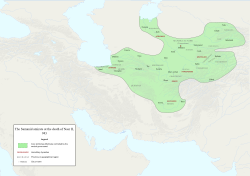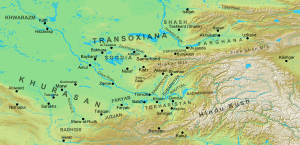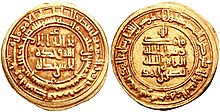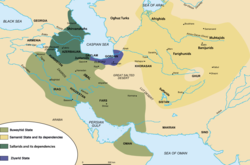Samanid Empire
Samanid Empire سامانیان | |||||||||||||||||||||||||||||||||
|---|---|---|---|---|---|---|---|---|---|---|---|---|---|---|---|---|---|---|---|---|---|---|---|---|---|---|---|---|---|---|---|---|---|
| 819–999 | |||||||||||||||||||||||||||||||||
 Extent of the Samanid realm at the death of Nasr II in 943 | |||||||||||||||||||||||||||||||||
| Capital | |||||||||||||||||||||||||||||||||
| Common languages | |||||||||||||||||||||||||||||||||
| Religion | Nestorianism, Zoroastrianism) | ||||||||||||||||||||||||||||||||
| Government | Hereditary monarchy | ||||||||||||||||||||||||||||||||
| Amir (Emir) | |||||||||||||||||||||||||||||||||
• 819–864/5 | Ahmad ibn Asad | ||||||||||||||||||||||||||||||||
• 999 | 'Abd al-Malik II | ||||||||||||||||||||||||||||||||
| Historical era | Middle Ages | ||||||||||||||||||||||||||||||||
• Established | 819 | ||||||||||||||||||||||||||||||||
• Disestablished | 999 | ||||||||||||||||||||||||||||||||
| Area | |||||||||||||||||||||||||||||||||
| 928 est.[6][7] | 2,850,000 km2 (1,100,000 sq mi) | ||||||||||||||||||||||||||||||||
| |||||||||||||||||||||||||||||||||
The Samanid Empire (Persian: سامانیان, romanized: Sāmāniyān), also known as the Samanian Empire, Samanid dynasty, Samanid amirate, or simply as the Samanids, was a Persianate Sunni Muslim empire, of Iranian dehqan origin. The empire was centred in Khorasan and Transoxiana; at its greatest extent encompassing northeastern Iran and Central Asia, from 819 to 999.
Four brothers—
The Samanid Empire is part of the
The Samanids promoted the arts, giving rise to the advancement of science and literature, and thus attracted scholars such as
History
Origins
The Samanid dynasty was founded by
Rise
The Samanids in Herat (819–857)
Ilyas died in 856, and his son Ibrahim ibn Ilyas became his successor. The Tahirid governor of Khorasan, Muhammad ibn Tahir, subsequently appointed him as the commander of his army, and sent him on an expedition against the Saffarid ruler Ya'qub ibn al-Layth al-Saffar in Sistan. After facing defeat in battle near Pushang in 857, he fled to Nishapur, only to be captured by Ya'qub al-Saffar and sent to Sistan as a hostage.[14]
The Samanid dynasty in Transoxiana (819–892)

In 839/40, Nuh seized
Meanwhile, the Tahirids' authority had significantly weakened after suffering several defeats to Saffarid ruler Ya'qub al-Saffar. Hence, causing the Tahirids to lose their grip over the Samanids, who became more or less independent. Nasr I, used this opportunity to strengthen his authority by sending his brother Ismail to Bukhara, which was in an unstable condition after suffering from raids by the Afrighid dynasty of Khwarazm. When Ismail reached the city, he was warmly received by its inhabitants, who saw him as one who could restore order.[16]
After not so long, disagreement over where to distribute tax money caused a conflict between the brothers. Ismail was eventually victorious in the dynastic struggle and took control of the Samanid state. However, Nasr had been the one who had been invested with Transoxiana, and the Abbasid
Final unification and height of power (892–907)

Following Nasr's death, Ismail moved the capital of the Samanid dynasty from Samarkand to Bukhara.[18] A few months later the Saffarid emir, Ya'qub al-Saffar, also died and was succeeded by his brother Amr ibn al-Layth, who saw himself as the heir of the Saffarids.[19] In the spring of 900, Amr clashed with Ismail near Balkh, but was defeated and taken into captivity.[20] Ismail thereafter sent him to Baghdad, where he was executed.[21] Ismail was thereafter recognized as the ruler of all of Khorasan and Transoxiana by the caliph.[21] Furthermore, he also received the investiture over Tabaristan, Ray and Isfahan.[21] It was also during this period that the Afrighid dynasty was forced into submission.[21]
Before Ismail Samani's major victory against the Saffarids, he had made various expeditions in Transoxiana; in 892, he put an end to the
In 900, Ismail sent an army under Muhammad ibn Harun al-Sarakhsi against Muhammad ibn Zayd, the Zaydi ruler of Tabaristan and Gorgan. The invasion was successful; Muhammad ibn Zayd was killed and Tabaristan was conquered by the Samanids. However, Muhammad ibn Harun shortly revolted, forcing Ismail himself to invade the region the following year. Muhammad ibn Harun thereafter fled to Daylam, while Ismail reconquered Tabaristan and Gorgan.[26] In 901, Amr Saffari was defeated at the battle of Balkh by the Samanids, which reduced the Saffarid dynasty to a minor tributary in Sistan.[27] It was during this period that the Samanids were at their height of power, ruling as far as Qazvin in the west[28] and Peshawar in the east.
Ismail is known in history as a competent general and a strong ruler; many stories about him are written in Arabic and Persian sources. Furthermore, because of his campaigns in the north, his empire was so safe from enemy incursions that the defences of Bukhara and Samarkand went unused. However, this later had consequences; at the end of the dynasty, the walls—earlier strong, but now falling apart—were greatly missed by the Samanids, who were constantly under attack by the
Ismail died in November 907, and was succeeded by his son Ahmad Samani (r. 907–914).
Intermediate period (907–961)
KUTAS
Not long after his accession, Ahmad invaded Sistan; by 911, Sistan was under complete Samanid control, and Ahmad's cousin Abu Salih Mansur was appointed as its governor. Meanwhile, an Alid named Hasan al-Utrush was slowly re-establishing Zaydi over Tabaristan. In 913, Ahmad sent an army under Muhammad ibn Sa'luk to deal with him. Although the Samanid army was much larger, Hasan managed to emerge victorious. Ahmad, before he could plan another expedition to Tabaristan, was the following year murdered by some of his slaves in a tent near Bukhara.[29] During his reign, Ahmad is also said to have replaced the language of the court from Persian to Arabic, which made him unpopular among his subjects, and forced him to change it back to Persian. After Ahmad's death, his eight-year-old son Nasr II (r. 914–943) succeeded him.

Due to Nasr's youth, his prime minister Abu 'Abd-Allah al-Jaihani took care over most of the state affairs. Jaihani was not only an experienced administrator, but also a prominent geographer and greatly educated man. Almost right after Nasr II had ascended the throne, several revolts erupted, the most dangerous one being under his paternal grand-uncle, Ishaq ibn Ahmad, who seized Samarkand and began minting coins there, while his son Abu Salih Mansur seized Nishapur and several cities in Khorasan. Ishaq was eventually defeated and captured, while Abu Salih Mansur died of natural causes in 915.[29] Some time later Nasr II once again had to deal with rebels; in 919, the governor of Khorasan, Husayn ibn Ali Marvarrudhi, rebelled against Samanid authority. Nasr responded by sending an army under Ahmad ibn Sahl to suppress the rebellion, which the latter managed to accomplish. After a few weeks, however, Ahmad shortly rebelled himself at Nishapur, made incursions into Gorgan, and then fortified himself in Merv to avoid a Samanid counter-attack. Nevertheless, the Samanid general Hamuya ibn Ali managed to lure Ahmad out of Merv, and defeated him in a battle at Marw al-Rudh; he was captured and imprisoned in Bukhara, where he remained until his death in 920.
In the west, Nasr II clashed several times with
In 943 several Samanid army officers, angry at Nasr's support of
Right when Nuh I ascended the throne, a revolt erupted in Khwarazm, which he managed to suppress. Later in 945, he had to deal with the
When Abu Ali Chaghani received the news of the re-capture of Bukhara, he once again marched towards it, but was defeated by an army sent by Nuh and withdrew back to Chaghaniyan. After some time, he left the region and tried to obtain support from other Samanid vassals. Meanwhile, Nuh had Chaghaniyan ravaged

By 945, the Turkic military slave faction (who were formerly recruited by the Samanid rulers in positions of governance) were fully in charge of the government. By this time, the Samanid family only held nominal power; similar to how the
Decline and fall (961–999)
The power of the Samanids began to crumble in the latter half of the 10th century. In 962, one of the
In 992, a
Isma'il Muntasir's attempt to resurrect the Samanid state (1000–1005)

Isma'il Muntasir was the youngest son of Nuh II—he was imprisoned by the Karakhanids after their conquest of Bukhara in 999. Some time later, Isma'il managed to escape to Khwarazm, where he gained support. Driving the Karakhanids out of Bukhara, he then moved on to and captured Samarkand. The approach of the Karakhanid army, however, forced Isma'il to give up all of his possessions, following which he travelled to Khorasan, where he captured Nishapur. Mahmud's army, however, made its way to the region, and Isma'il decided it necessary to flee again.
In 1003 Isma'il came back to Transoxiana, where he requested and received assistance from the Oghuz Turks of the
Fleeing to Khorasan yet again, Isma'il attempted to reenter Transoxiana in the end of 1004. The Karakhanids stopped this and Isma'il was nearly killed. Following this, he sought the hospitality of an
Iranian intermezzo
Along with several other states, the Samanid Empire was part of the
Culture
Government

Obverse in Middle Persian: khvarrah apzut shahanshah "the King of Kings has increased the royal splendor"
Reverse in Arabic: la ilaha illa allah wahdahu la sharik lahu muhammad rasul allah al-muti' lillah al-malik al-muzaffar mansur bin nuh "There is no god but Allah, the One, there is no partner to Him, Muhammad is the messenger of Allah, al-Muti' lillah, the victorious king, Mansur son of Nuh.
The system of the Samanid state was modelled after the Abbasid system,
Like in the Abbasid Caliphate, Turkic slaves could rise to high office in the Samanid state, which would sometimes give them enough power to nearly make the ruler their puppet.[46]
Cultural and religious efforts

The Samanids revived
Although the Zoroastrian population had previously been suppressed by the Abbasid Caliphate,[56] according to Al-Masudi, the Samanid empire[b][57] still had fire-temples that were still being venerated by the present Zoroastrian population.[57] Despite the fact that the Samanids professed Sunni Islam, however, they were much more tolerant towards its Zoroastrian population than the previous empires.[58]
Through zealous missionary work as many as 30,000 tents of
Under Nuh II, a Hanafi work, which was being used to contest Ismailism, was translated into Persian.[59]
Agriculture and trading were the economic bases of the Samanid State. The Samanids heavily engaged in trade with Europe. Thousands of Samanid coins have been found in the Baltic and Scandinavia.[60]
Literature
During the 9th and 10th centuries, there was a large amount of growth in literature, mostly in poetry. It was during the Samanid period that
Although Persian was the most-favored language,
The acknowledged founder of Persian classical poetry, and a man of great perception, was Rudaki, who was born in the village of Panjrudak, which is today part of the Panjakent District in Tajikistan.[61] Rudaki was already becoming popular during his early years, due to his poems, his voice, and his great skill in using the chang (an Iranian instrument similar to the harp). He was shortly invited to the Samanid court, where he stayed almost the rest of his life. Fewer than 2,000 lines of his poetry have survived, but are enough to prove his great poetic skills—he perfected every basic verse form of medieval Persian poetry: mathnawi, qasida, ghazal and ruba'i.[62]
"Look at the cloud, how it cries like a grieving man
- Thunder moans like a lover with a broken heart.
- Now and then the sun peeks from behind the clouds
- Like a prisoner hiding from the guard." – Rudaki
Another prominent poet was Shahid Balkhi, born in the village of Jakhudanak near Balkh. Not much is known about his life, but he is mentioned as being one of the best poets in the court of Nasr II, and one of the best scholars of the age. He was also a student of Rudaki, and had close relations with him. He died in 936, a few years before Rudaki's death. His death saddened Rudaki, who afterwards wrote an emotional elegy about him.[62]
Daqiqi, who was a native of
However, the most prominent poet of that age was Ferdowsi, born in Tus in 940 to a dehqan family. It was during his youth that there was a period of growth under the Samanids. The rapid growth of interest in ancient Iranian history made him continue the work of Daqiqi, completing the Shahnameh in 994, only a few years before the fall of the Samanid Empire. He later completed a second version of the Shahnameh in 1010, which he presented to the Ghaznavid Sultan Mahmud. However, his work was not as appreciated by the Ghaznavids as it had been by the Samanids.[62]
Population
Under the Samanid Empire, the
Language
Ferghana, Samarkand, and Bukhara were starting to be linguistically Persianized in originally Khwarazmian and Sogdian areas during Samanid rule.[64] The Persian language spread and led to the extinction of Eastern Iranian languages like Bactrian and Khwarezmian with only a tiny amount of Sogdian-descended Yaghnobi speakers remaining among the now Persian-speaking Tajik population of Central Asia. This was due to the fact that the Arab-Islamic army which invaded Central Asia at the time also included some Persians who later governed the region like the Samanids.[65] Persian was rooted into Central Asia by the Samanids.[4]
Intellectual life
In the 9th and 10th centuries, intellectual life in Transoxiana and Khorasan reached a high level. In the words of N.N. Negmatov, "It was inevitable that the local Samanid dynasty, seeking support among its literate classes, should cultivate and promote local cultural traditions, literacy and literature."[66]
The main Samanid towns –
Arts
Due to extensive excavations at Nishapur, Iran, in the mid-twentieth century, Samanid pottery is well-represented in Islamic art collections around the world. These ceramics are largely made from earthenware and feature either calligraphic inscriptions of Arabic proverbs, or colorful figural decorations.[68] The Arabic proverbs often speak to the values of "Adab" culture—hospitality, generosity, and modesty.[69]
-
Lute player. Samanid (orKhorezm, 10th century. Islamic Art Museum (Museum für Islamische Kunst), Berlin.[71]
-
"Simurgh platter", Iran, Samanid dynasty. 9th-10th century. Islamic Art Museum (Museum für Islamische Kunst), Berlin.
-
Bowl with Arabic inscription "Planning before work protects you from regret; prosperity and peace", 10th century CE, Iran.
Legacy
In commending the Samanids, the epic Persian poet Ferdowsi says of them:
کجا آن بزرگان ساسانیان
ز بهرامیان تا به سامانیان
"Where have all the great Sasanians gone?
From the
A Bukharian historian writing in 943 stated that Ismail Samani:
was indeed worthy and right for padishahship. He was an intelligent, just, compassionate person, one possessing reason and prescience...he conducted affairs with justice and good ethics. Whoever tyrannized people he would punish...In affairs of state he was always impartial.[72]
The celebrated scholar Nizam al-Mulk, in his famous work Siyasatnama, stated that Ismail Samani:
was extremely just, and his good qualities were many. He had pure faith in God (to Him be power and glory) and he was generous to the poor – to name only one of his notable virtues.[73]
The
Samanid rulers
| Bukhara | Samarkand | Ferghana | Shash | Herat | |
|---|---|---|---|---|---|
Umayyad governor of Khorasan, Asad ibn Abdallah al-Qasri , under whose influence he became a Muslim and served the governor till his death. He was the founder of the Samanid dynasty)
| |||||
| Asad ibn Saman Persian: اسد بن سامان | |||||
| Nuh ibn Asad Persian: نوح بن اسد 819–841/2 |
Ahmad ibn Asad Persian: احمد بن اسد 819–864/5 |
Yahya ibn Asad Persian: یحییٰ بن اسد 819–855 |
Ilyas ibn Asad Persian: الیاس بن اسد 819–856 | ||
| Ahmad ibn Asad Persian: احمد بن اسد 819–864/5 |
Ibrahim ibn Ilyas Persian: ابراهیم بن الیاس 856–867 | ||||
Abu Ibrahim Isma'il ibn Ahmad : ابو ابراهیم اسماعیل بن احمدPersian 892–907 |
Nasr I Persian: نصر بن احمد 864–892 |
Ya'qub ibn Ahmad Persian: یعقوب بن احمد ? |
Saffarids | ||
Abu Ibrahim Isma'il ibn Ahmad : ابو ابراهیم اسماعیل بن احمدPersian 892–907 |
|||||
| Ahmad ibn Isma'il Persian: احمد بن اسماعیل 907–914 |
|||||
| Nasr II Persian: ابوالحسن نصر بن احمد 914–943 |
|||||
| Nuh I Persian: نوح بن نصر 943–954 |
|||||
| Ibrahim ibn Ahmad Persian: ابراهیم بن احمد 947 |
|||||
| Abd al-Malik ibn Nuh I Persian: عبدالملک بن نوح 954–961 |
|||||
| Abu Salih Mansur ibn Nuh I Persian: ابو صالح منصور بن نوح 961–976 |
|||||
| Nuh ibn Mansur Persian: نوح بن منصور 976–997 |
|||||
| Abd al-Aziz Persian: عبدالعزیز 992 |
|||||
| Abu'l-Harith Mansur ibn Nuh II Persian: ابو الحارث منصور بن نوح 997–999 |
|||||
| Abd al-Malik ibn Nuh II Persian: عبدالمالک بن نوح 999 |
|||||
| Isma'il Muntasir ibn Nuh II Persian: اسماعیل منتصر بن نوح 1000 – 1005 |
|||||
| ? | |||||
See also
| History of Iran | |
|---|---|
 | |
| 3200–2700 | |
| Jiroft culture | c. 3100–2200 |
| Lullubi Kingdom/Zamua | c. 3100-675 |
| Elam | 2700–539 |
| Marhaši | c. 2550-2020 |
| Oxus Civilization | c. 2400–1700 |
| Akkadian Empire | 2400–2150 |
| Kassites | c. 1500–1155 |
| Avestan period | c. 1500–500 |
| Neo-Assyrian Empire | 911–609 |
| Urartu | 860–590 |
| Mannaea | 850–616 |
| Zikirti | 750-521 |
| Saparda | 720-670 |

![Lute player. Samanid (or Seljuk)[70] metal work, Khorezm, 10th century. Islamic Art Museum (Museum für Islamische Kunst), Berlin.[71]](http://upload.wikimedia.org/wikipedia/commons/thumb/6/66/Seljuk_Islamic_Art_%2828085489314%29.jpg/200px-Seljuk_Islamic_Art_%2828085489314%29.jpg)


